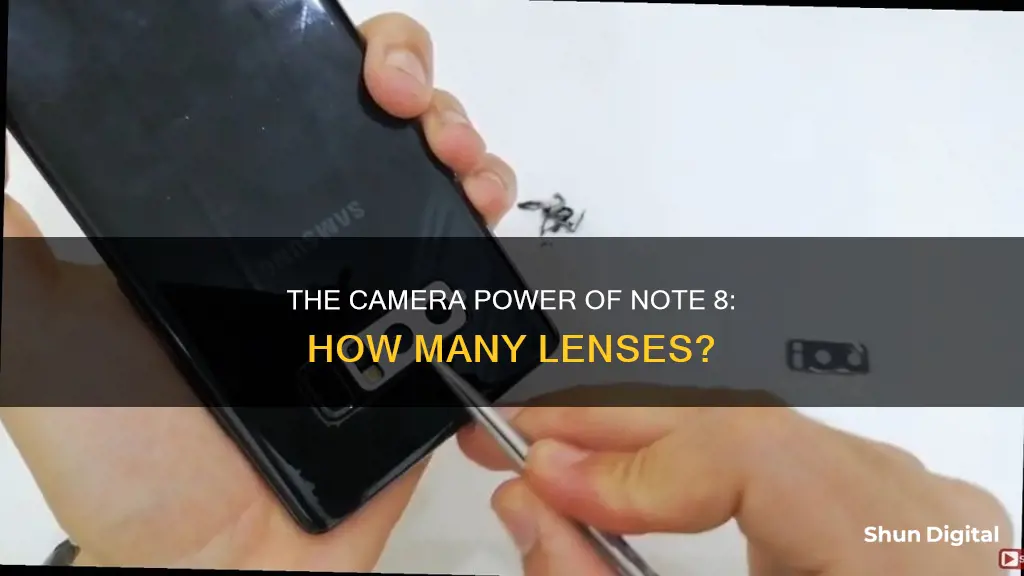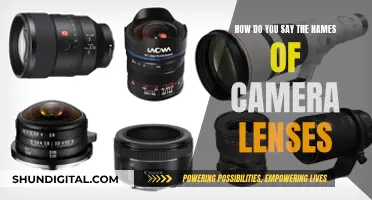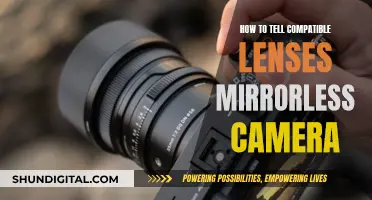
The Samsung Galaxy Note 8 is a smartphone phablet that was unveiled on 23 August 2017 and released on 15 September 2017. It is the successor to the Samsung Galaxy Note 7, which was discontinued due to a battery catastrophe. One of the most notable features of the Note 8 is its dual-lens camera system, which was a first for Samsung smartphones. The rear of the device is equipped with a 12-megapixel wide-angle lens and a 12-megapixel telephoto lens, both offering optical image stabilization. This camera setup provides improved zoom capabilities and enhanced depth of field, allowing for creative photography and video effects.
| Characteristics | Values |
|---|---|
| Number of camera lenses | 2 |
| Rear camera lens types | Telephoto and wide-angle |
| Rear camera lens megapixels | 12 MP each |
| Rear camera lens aperture | f/2.4 and f/1.7 |
| Rear camera lens stabilization | Optical Image Stabilization (OIS) on both lenses |
| Front camera | Yes |
| Video recording | 2160p (4K) at 30fps, 1080p (Full HD) at up to 60fps, 720p (HD) slow motion at up to 240fps |
What You'll Learn

The Samsung Galaxy Note 8 has a dual-camera system
The dual-camera system enables several new features. Firstly, it allows for 2x optical zoom without any loss in quality, and up to 10x zoom with minimal degradation. This is particularly useful for capturing clearer photos of subjects that are further away. Secondly, the two lenses can be used together to capture photos with enhanced depth of field, similar to the Portrait Mode on the iPhone 7 Plus and the OnePlus 5. This is achieved by combining the information from both cameras. Thirdly, the dual-camera system allows for a feature called "Dual Capture", where both lenses take individual photos of the same subject simultaneously, resulting in both a close-up shot and a telephoto shot from a distance.
The dual-camera system also enables a feature called "Live Focus", which is Samsung's version of the artificial background blurring feature often called "Portrait Mode" on other smartphones. Live Focus allows users to adjust the severity of the blur in real time, as well as after the photo has been taken. This is possible because the depth data is maintained with every photo, so it can be altered and saved as a new photo. Additionally, Live Focus provides guidance on how to optimise the photo by telling users if they need to move forward or backward to get the ideal depth of field.
The Samsung Galaxy Note 8's dual-camera system offers several benefits and opens up new possibilities for mobile photography, providing users with more creative control and improved image quality.
Pentax Lenses: Compatibility with Pentax Cameras
You may want to see also

One lens is a wide-angle camera, the other is a telephoto lens
The Samsung Galaxy Note 8 is the first smartphone from the company to feature a dual-camera system. One lens is a wide-angle camera, the other is a telephoto lens. Both lenses have a 12-megapixel resolution and optical image stabilization. The wide-angle lens has an aperture of f/1.7, while the telephoto lens has an aperture of f/2.4. This means the telephoto lens is a "slower" lens, requiring more light to capture an image.
The wide-angle lens is similar to that of the Galaxy S8, with a 28mm field of view. The telephoto lens has twice the focal length of the wide-angle lens, allowing for 2x optical zoom with no loss in quality. This zoom feature is simple to use, with a ""2x" button in the viewfinder window. The telephoto lens also has optical image stabilization, which helps to keep images sharp, especially at longer focal lengths.
The dual-camera system allows for several new features. One is "Live Focus", which creates a shallow depth of field effect, keeping the subject in focus while blurring the background. This feature can be adjusted before and after taking the photo, and can also be used to guide the user to optimize the photo by suggesting to move forward or backward to get the ideal depth of field. Another feature is "Dual Capture", which allows both cameras to take photos simultaneously, resulting in both a standard-distance and a telephoto shot.
The Evolution of Camera Lenses: Losing Sharpness Over Time?
You may want to see also

Both lenses have 12MP resolution
The Samsung Galaxy Note 8 is the first Samsung phone to feature a dual-camera system. Both lenses have 12MP resolution. The primary shooter is a wide-angle lens with an f/1.7 aperture, while the secondary lens is a telephoto lens with an f/2.4 aperture. This setup offers several benefits, including the ability to zoom up to 2x with no loss in quality and enhanced depth of field.
The wide-angle lens on the Note 8 has an f/1.7 aperture, which is wider than the f/1.8 aperture found on the iPhone 8 and iPhone X. This allows for a brighter image with more light capture. Additionally, the telephoto lens on the Note 8 has optical image stabilisation (OIS), which is not present on the iPhone 8 Plus' telephoto lens. OIS helps to compensate for handshake and keeps the image sharp, especially at longer focal lengths.
The dual-camera system on the Note 8 also enables a feature called "Live Focus", which allows users to adjust the level of background blur in their photos. This can be done in real-time while taking the photo or after the fact, as the depth data is maintained with every photo. Live Focus also provides guidance on how to optimise the subject in the foreground by telling users whether to move forward or backward to get the ideal depth of field.
Another feature made possible by the dual-camera system is "Dual Capture", which allows users to take photos with both lenses simultaneously, resulting in both a standard-distance and a telephoto shot from a single snap. This adds versatility to the camera and gives users more options for composing their images.
The 12MP resolution on both lenses of the Note 8's dual-camera system, along with the wide-angle and telephoto capabilities, optical image stabilisation, and software features like Live Focus and Dual Capture, make it a powerful and versatile camera setup for smartphone photography.
Polarized Lenses vs UV Camera Filters: What's the Difference?
You may want to see also

Both lenses have optical image stabilization
The Samsung Galaxy Note 8 is the first smartphone from the company to feature a dual-camera system. This consists of a 12-megapixel wide-angle lens and a 12-megapixel telephoto lens, with both featuring optical image stabilization (OIS). This is a significant advantage over competitors such as the iPhone 7 Plus, which only has OIS on its wide-angle lens.
Optical image stabilization helps to compensate for handshake at longer focal lengths, which can cause image blur. By including OIS on the telephoto lens, Samsung has ensured that longer zoomed shots are more stable and sharper. This is particularly important as handshake is more noticeable at longer focal lengths. The inclusion of OIS on both lenses also allows the Note 8 to utilize its telephoto camera more frequently, even in low-light conditions, as it is not limited to using the regular camera in such situations.
The wide-angle lens has an aperture of f/1.7, while the telephoto lens has an aperture of f/2.4. The telephoto lens provides 2x optical zoom, allowing for clearer photos of subjects that are further away, without any loss in quality. The telephoto lens also has a slower lens, meaning it lets in less light, which can be a limitation for low-light photography. However, the addition of a stabilization module to the telephoto lens helps to compensate for this by allowing for longer shutter speeds without introducing blur.
The dual-camera system enables several new software features. For example, Samsung's "Live Focus" mode allows users to adjust the level of background blur before and after capturing photos, creating a shallow depth of field effect similar to that of a professional camera. The dual-camera system also enables a "Dual Capture" mode, which takes photos with both lenses simultaneously, providing both a standard-distance and a telephoto shot of the same subject.
Directv Protection Plan: What Camera Lens Damage Is Covered?
You may want to see also

The wide-angle lens has an aperture of f/1.7, the telephoto lens has an aperture of f/2.4
The Samsung Galaxy Note 8 is the first Samsung phone to feature a dual-camera system. The wide-angle lens has an aperture of f/1.7, while the telephoto lens has an aperture of f/2.4. Both lenses have a 12-megapixel resolution and optical image stabilisation (OIS).
The wide-angle lens has a field of view of roughly 28mm, and Samsung refers to it as the “primary shooter". This lens is optically stabilised and has a maximum aperture of f/1.7, which allows for more light to enter the lens. This results in brighter and sharper images, even in low-light conditions. The wide-angle lens is ideal for landscape photography and provides a wider field of view, allowing more of the scene to be captured in the frame.
On the other hand, the telephoto lens has a narrower field of view, equivalent to a focal length of about 52mm. This lens provides a 2x optical zoom, allowing you to get closer to your subject without losing image quality. The telephoto lens has an aperture of f/2.4, which is slightly narrower than the wide-angle lens. However, it still performs well in low-light conditions due to the optical image stabilisation. The telephoto lens is perfect for capturing distant subjects, portraits, and situations where you want to blur the background.
The combination of these two lenses offers several benefits. Firstly, you can zoom up to 2x with no noticeable loss in image quality, and up to 10x with minimal degradation. Secondly, you can capture photos with enhanced depth of field, creating a beautiful bokeh effect, especially in portrait photography. Additionally, the dual-lens system allows you to take photos with both lenses simultaneously, giving you the option to choose the desired shot later.
The Samsung Galaxy Note 8's camera system, with its wide-angle and telephoto lenses, offers versatility, improved image quality, and creative possibilities for photographers and enthusiasts alike.
Target's Camera Lens Offerings: What You Need to Know
You may want to see also
Frequently asked questions
The Note 8 has two camera lenses, a wide-angle lens, and a telephoto lens.
The wide-angle lens has a 12MP sensor with an optically-stabilized f/1.7 lens and a field of view of roughly 28mm. The telephoto lens is also 12MP but has an optically-stabilized f/2.4 lens.
Having two camera lenses offers several advantages, including the ability to take clearer photos of distant subjects, capture photos with enhanced depth of field, and utilize optical zoom without loss of quality.







